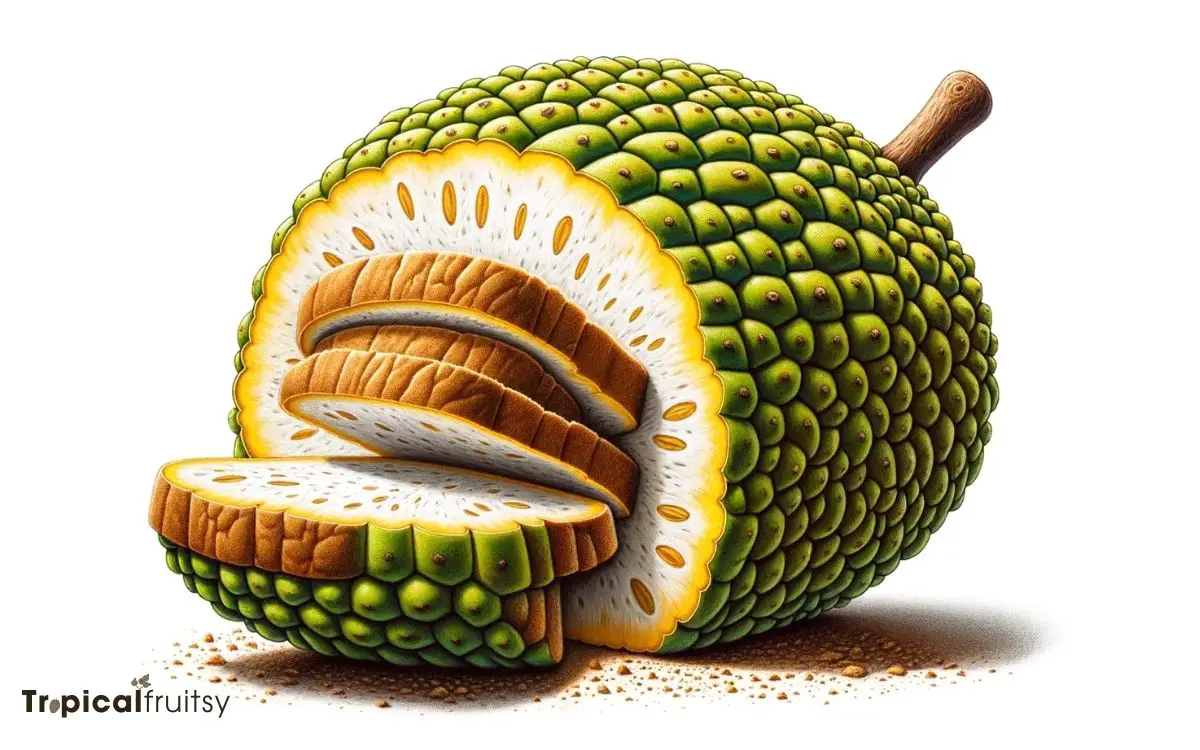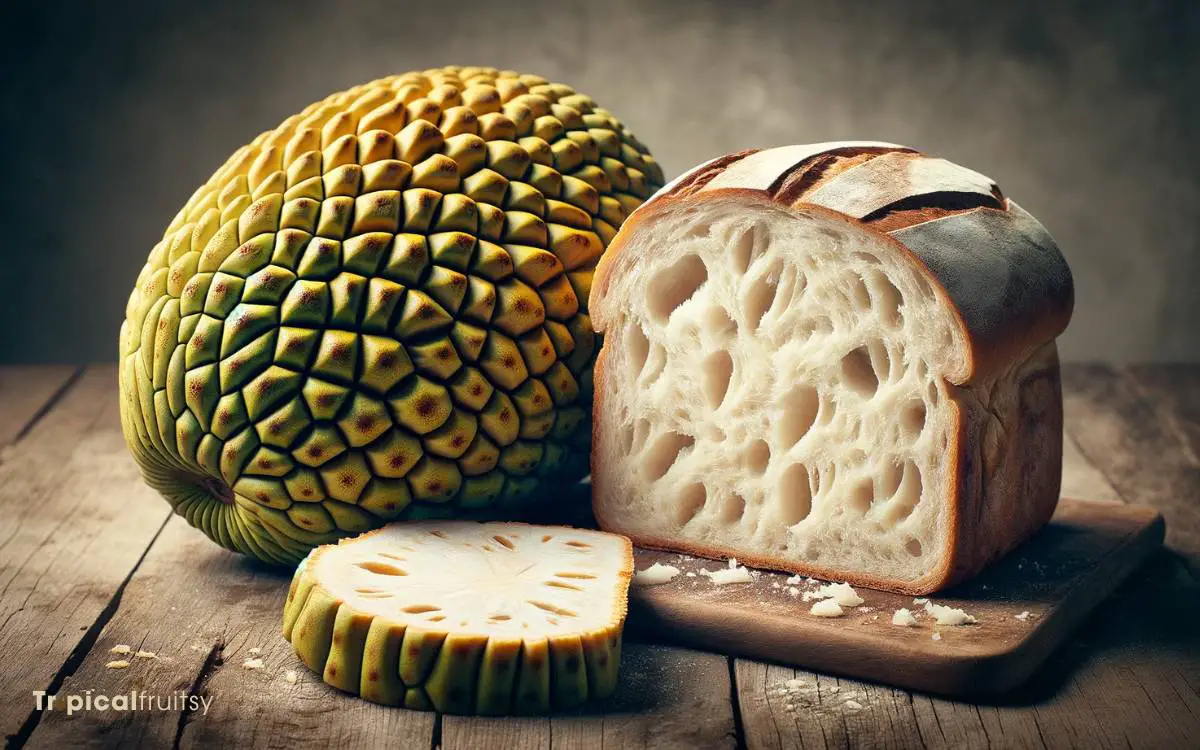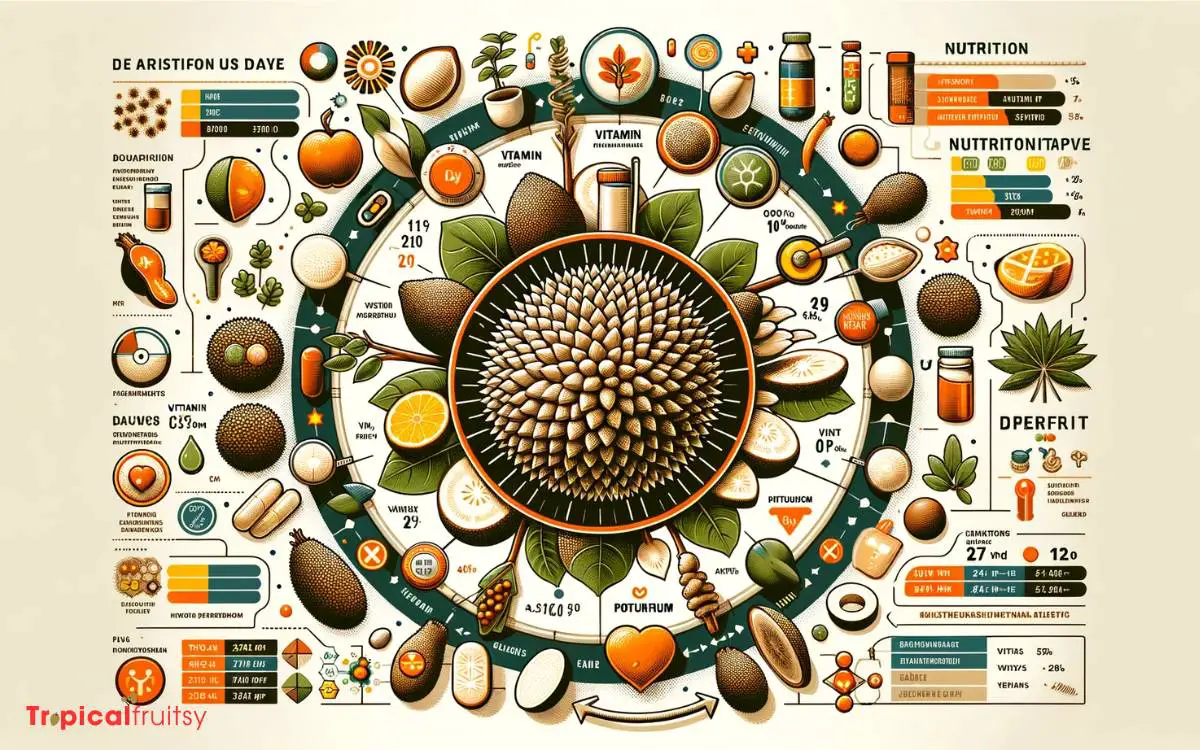Why Is Breadfruit Called Breadfruit? Explained!
Breadfruit is called such due to its bread-like taste and texture when cooked. The fruit’s scientific name is Artocarpus altilis and it is a staple in many tropical regions.
The name ‘breadfruit’ is derived from the fruit’s characteristics when cooked.
It is:
The term also reflects its historical importance:
- Breadfruit is a high-yield crop.
- It has been crucial in sustaining populations in places like Oceania.
In the Pacific Islands, roasted breadfruit is often used as a bread substitute due to its similar texture and filling nature.
Breadfruit’s name encapsulates its resemblance to bread and its significance as a tropical dietary staple.

Key Takeaway
Breadfruit Attributes: Descriptions and Significance
| Attribute | Description |
|---|---|
| Scientific Name | Artocarpus altilis |
| Shape | Large and round |
| Nature | Starchy |
| Cooked Texture | Similar to freshly baked bread |
| Taste | Mild, potato-like |
| Role in Diet | Staple food in tropical regions |
| Historical Significance | Sustenance crop for populations in Oceania and beyond |
Uncovering Breadfruit’s Origins

The breadfruit, a staple in tropical regions, traces its origins to the lush forests of New Guinea and the Indo-Malay region.
Botanically known as Artocarpus altilis, this species belongs to the Moraceae family, which also includes figs and mulberries.
Its domestication is believed to have occurred thousands of years ago, and over centuries, its cultivation spread throughout Oceania and other tropical areas.
Genetic studies suggest a single domestication event in this extensive distribution.
The tree’s ability to provide high yields of nutritious fruit with minimal care made it integral to agrarian societies in these regions.
The fruit’s name derives from its starchy interior and bread-like texture when cooked, providing a vital source of complex carbohydrates to indigenous populations.
The Texture Connection

The morphological attributes of breadfruit reveal a noteworthy similarity to traditional bread in terms of texture, which is one of the primary factors in its nomenclature.
Upon cooking, breadfruit undergoes a transformative process where its flesh softens, developing a texture reminiscent of freshly baked bread, with a soft and spongy consistency.
This starchy fruit’s consistency aligns closely with that of bread, particularly when comparing the structural changes that starches undergo during the thermally induced gelatinization process.
Similar to Bread
Breadfruit’s unique texture, akin to freshly baked bread when cooked, underpins its nomenclature.
The flesh of this tropical fruit exhibits a remarkable transformation upon application of heat, transitioning from a firm, potato-like consistency to a softer, starchy texture that closely resembles that of bread.
This textural metamorphosis is a key aspect of the fruit’s culinary versatility and appeal.
| Aspect | Breadfruit |
|---|---|
| Raw Texture | Firm, akin to raw potato |
| Cooked Texture | Soft, bread-like |
| Mouthfeel | Moist, slightly springy |
Scientifically, it is the fruit’s high starch content that is responsible for this impression of breadiness.
Starches gelatinize when heated, engendering a fluffy, spongy consistency that is both palatable and satisfying. This molecular alteration is pivotal to breadfruit’s gastronomic identity.
Cooked Texture Changes
Upon cooking, one observes that breadfruit undergoes a profound textural evolution, transitioning from its raw, dense form to a fluffy consistency reminiscent of leavened dough.
This transformation is attributable to the thermal breakdown of complex starches within the fruit’s cellular matrix.
Heat application initiates the gelatinization of starch granules, a process where they absorb water, swell, and eventually rupture.
This action disrupts the rigid structure of the raw state, leading to the softening of the fruit’s flesh.
Additionally, non-covalent bonds within the proteins begin to denature, further contributing to the shift in texture.
The resultant mouthfeel—soft and bread-like—is what gives breadfruit its nomenclature, aligning its cooked properties with that of traditional baked bread.
Starchy Consistency Comparison
In comparison to other starchy staples, breadfruit’s cooked texture bears a striking resemblance to freshly baked bread, solidifying the etymological link between its culinary characteristics and its name.
When mature, the fruit’s flesh becomes soft and spongy, akin to the crumb of white bread — a texture not commonly found in other fruits.
This unique quality is due to the high starch content, which undergoes gelatinization during cooking, transforming the fruit’s texture into something remarkably bread-like.
| Staple | Texture When Cooked | Starch Content |
|---|---|---|
| Breadfruit | Soft and spongy | High |
| Potato | Fluffy or creamy | Moderate to high |
| Rice | Tender, sometimes sticky | High |
| Plantain | Firm and starchy | Moderate |
| Cassava | Soft and doughy | High |
This table highlights the diversity in texture among common starch sources, emphasizing breadfruit’s unique bread-like consistency.
Culinary Versatility Explored

One can appreciate the culinary versatility of breadfruit, which ranges from its use in traditional dishes to innovative modern cuisine.
This tropical staple can be consumed at various stages of ripeness, providing a spectrum of textures and flavors.
In its immature state, the breadfruit possesses a firm texture, suitable for boiling, frying, or replacing starchy vegetables in recipes.
As it matures, its starchy content transforms into sugars, yielding a softer consistency with a sweet taste, ideal for desserts and baked goods.
The fruit’s complex carbohydrate composition renders it an excellent energy source, and its high vitamin and mineral content contributes to its nutritional profile.
Contemporary chefs are exploring breadfruit’s potential in gluten-free products and as a sustainable food source, further enhancing its culinary repertoire.
Historical Uses and Nomenclature

Breadfruit, a staple food in many tropical regions, derives its name from the bread-like texture it acquires when cooked.
The fruit has been a significant source of sustenance for centuries, particularly in Pacific Island cultures.
Historical records suggest that the name ‘breadfruit’ was given by European explorers who observed its use as a bread substitute in native diets.
To make the writing more enjoyable and relatable, here’s a table highlighting various aspects of breadfruit’s nomenclature and historical uses:
| Aspect | Detail |
|---|---|
| Origin of Name | Texture resembling freshly baked bread when cooked |
| Early Documentation | European explorers in the 17th century |
| Cultural Significance | Staple food in Pacific cultures |
| Linguistic Variations | Known as ‘ulu’ in Hawaiian and ‘kuru’ in Tahitian |
Comparing Breadfruit and Bread

Examining the similarities between breadfruit and conventional bread reveals the rationale behind the fruit’s evocative name.
Texturally, the starchy flesh of mature breadfruit resembles the soft crumb of freshly baked bread, particularly when cooked.
The fruit’s natural fermentation can also yield a slightly yeasty scent, reminiscent of leavened bread.
Additionally, breadfruit’s versatility in preparation methods—roasted, fried, or boiled—allows for a range of consistencies that can mirror those of different types of bread.
From a culinary perspective, breadfruit often serves as a carbohydrate-rich staple in diets where wheat may not be prevalent, functioning much like bread in providing a satiating, energy-dense component to meals.
This comparison sets the stage for exploring the fruit’s nutritional profile insights, which further delineate its role in human sustenance.
Nutritional Profile Insights

The nutritional composition of breadfruit is remarkable for its high carbohydrate content and array of essential vitamins and minerals, contributing to its status as a staple food in many tropical regions.
Breadfruit is a rich source of dietary fiber, which aids in digestion and helps maintain blood sugar levels.
It offers a significant amount of vitamin C, essential for immune function, and vitamin B complex, which includes thiamine, riboflavin, niacin, and pyridoxine, crucial for energy metabolism.
The fruit also provides minerals such as potassium, important for cardiovascular health, and magnesium, which plays a role in over 300 enzymatic reactions in the body.
Furthermore, it contains modest amounts of protein and is low in fat, making it a wholesome addition to a balanced diet.
Is the Name “Breadfruit” Related to its Seasonal Availability?
The name “Breadfruit” does not directly relate to its seasonal availability. In fact, breadfruit season explained goes beyond the moniker. This tropical fruit is actually available year-round in regions with a warm climate. Its name comes from its starchy texture when cooked, resembling the taste of freshly baked bread.
Cultural Significance Worldwide

Breadfruit holds a prominent position in the culinary traditions of many tropical regions, serving as a foundational ingredient akin to the role of potatoes or rice in other cultures.
Its significance extends beyond sustenance, having symbolic representations in various religious and communal rituals that underscore its integration into spiritual life.
Concurrently, numerous initiatives are underway to preserve the heritage and knowledge of breadfruit cultivation, recognizing its role in cultural identity and food security for future generations.
Traditional Cuisine Staple
Firmly established as a cornerstone in the culinary traditions of many tropical regions, breadfruit serves not only as a dietary staple but also carries deep cultural significance across the globe.
This multifaceted fruit is deeply rooted in the following aspects:
- Nutritional Provision: Breadfruit is rich in complex carbohydrates, dietary fiber, and essential vitamins, making it a vital component in ensuring food security in regions where it is cultivated.
- Culinary Versatility: Its ability to be processed into various forms—roasted, boiled, fried, or fermented—allows it to be integrated into a multitude of traditional dishes, enhancing local cuisines.
- Cultural Heritage: Breadfruit features prominently in rituals, traditions, and folklore, symbolizing abundance and community in many cultures where it has been consumed for generations.
Religious Symbolism
In many cultures, the breadfruit tree holds a sacred status, often intertwined with creation myths and spiritual practices.
Its prolific nature and life-sustaining fruit have made it an emblem of abundance and prosperity.
In the Pacific Islands, for example, the breadfruit is sometimes considered a kinolau, a physical manifestation of a god, signifying its deep spiritual importance.
Moreover, in Caribbean societies, where the breadfruit was introduced during colonial times, it has become part of the local cosmology, symbolizing resilience and adaptability.
The tree’s far-reaching roots metaphorically represent grounding and stability within communities, while the expansive canopy is seen as a protective embrace, sheltering the collective spirit.
This reverence underscores the tree’s integral role in both ecological sustenance and cultural heritage.
Heritage Preservation Efforts
Global conservation initiatives are actively working to preserve the cultural significance of breadfruit, recognizing its role as a staple food and a symbol of heritage in various communities around the world.
These initiatives are multifaceted, encompassing:
- Genetic Conservation: Efforts to protect and conserve the genetic diversity of breadfruit species, ensuring the sustainability and resilience of this important crop.
- Cultural Practices: Documentation and support for traditional farming and culinary practices associated with breadfruit, to maintain its cultural relevance and pass knowledge to future generations.
- Educational Outreach: Programs designed to educate the public about the historical importance of breadfruit and its potential in contemporary food security strategies.
These preservation efforts are essential in safeguarding breadfruit’s role in cultural identity, food sovereignty, and economic stability for many tropical regions.
Conclusion
Breadfruit’s appellation stems from its remarkable starchy texture and flavor profile, which, when cooked, bears a striking resemblance to freshly baked bread.
This botanical marvel not only enriches culinary traditions globally but also provides a cornucopia of nutrients essential for human health.
Its historical significance and cultural prominence underscore a profound narrative of sustenance and human innovation. Thus, breadfruit remains an emblematic testament to nature’s bountiful ingenuity.






